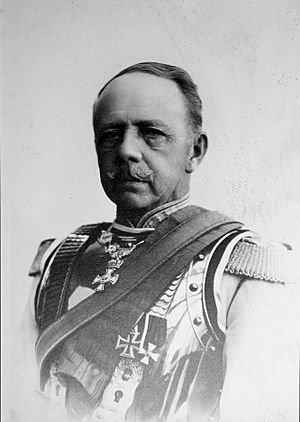Charles Alexander, Grand Duke of Saxe-Weimar-Eisenach facts for kids
Quick facts for kids Karl Alexander |
|||||
|---|---|---|---|---|---|
 |
|||||
| Grand Duke of Saxe-Weimar-Eisenach | |||||
| Reign | 8 July 1853 – 5 January 1901 | ||||
| Predecessor | Charles Frederick | ||||
| Successor | William Ernest | ||||
| Born | 24 June 1818 Weimar |
||||
| Died | 5 January 1901 (aged 82) Weimar |
||||
| Burial | Weimarer Fürstengruft | ||||
| Spouse | Sophie of the Netherlands | ||||
| Issue | Charles Augustus, Hereditary Grand Duke of Saxe-Weimar-Eisenach Marie, Princess Heinrich VII Reuss Princess Anna Sophia Elisabeth, Duchess Johann Albrecht of Mecklenburg |
||||
|
|||||
| House | Saxe-Weimar-Eisenach | ||||
| Father | Charles Frederick, Grand Duke of Saxe-Weimar-Eisenach | ||||
| Mother | Maria Pavlovna of Russia | ||||
| Religion | Lutheranism | ||||
Karl Alexander (born June 24, 1818 – died January 5, 1901) was a very important ruler. He was the Grand Duke of Saxe-Weimar-Eisenach from 1853 until he passed away. He was known for supporting arts, culture, and education.
Contents
Life of Karl Alexander
Early Life and Education
Karl Alexander was born in Weimar, a city in Germany. He was the second son of Karl Frederick, who was also a Grand Duke, and Grand Duchess Maria Pavlovna of Russia. His mother made sure he had a good education. She hired a Swiss scholar named Frédéric Soret to be his teacher. Soret was also a close friend of the famous writer Johann Wolfgang von Goethe.
Friendships and Becoming Grand Duke
When Karl Alexander was still a young prince, he became good friends with the writer Fanny Lewald and the famous fairy tale author Hans Christian Andersen. Andersen even wrote that he "quite loved the young duke" and found him very attractive. However, their close friendship ended in 1849 because of a war against Denmark. This war was about the areas of Schleswig-Holstein.
On July 8, 1853, Karl Alexander's father died. This meant Karl Alexander became the new Grand Duke. He waited until August 28, 1853, which was Goethe's birthday, to officially take on his new role.
Supporting Arts and Education
Karl Alexander was a big supporter of culture and education. He worked to restore Wartburg Castle, an old and important castle. He also helped improve the city of Weimar. He put up monuments for famous German writers like Goethe and Friedrich Schiller.
In 1860, he started the Weimar Saxon-Grand Ducal Art School. Famous artists like Arnold Böcklin and Franz von Lenbach taught there. As Grand Duke, he was also in charge of Jena University. He especially supported the university's collections, including a special collection of ancient coins from the Middle East.
Later Years and Legacy
During the Franco-Prussian War (1870–1871), Karl Alexander focused on helping people. He supported "Samaritan" efforts, which means he helped with medical aid and relief. Towards the end of his rule, in November 1900, a meeting called the Weimar Congress of the Goethe Federation took place. They described his time as ruler as the Silver Age of Weimar. This means it was a time of great cultural growth and peace, similar to a "golden age" but perhaps a bit less grand.
Karl Alexander passed away in Weimar in 1901. His only son, Carl August, had died before him. So, his grandson, Wilhelm Ernst, became the next Grand Duke.
Family and Children
On October 8, 1842, Karl Alexander married his first cousin, Princess Sophie of the Netherlands. Her father was William II, the King of the Netherlands. Sophie's mother was Grand Duchess Anna Pavlovna of Russia, who was also Karl Alexander's mother's sister.
Karl Alexander and Sophie had four children:
- Karl August (born 1844 – died 1894). He was the oldest son and was supposed to become Grand Duke after his father.
- Marie (born 1849 – died 1922). She married Prince Heinrich VII Reuss of Köstritz.
- Anna (born 1851 – died 1859). She passed away when she was young.
- Elisabeth (born 1854 – died 1908). She married Duke Johann Albrecht of Mecklenburg-Schwerin.
Images for kids
See also
 In Spanish: Carlos Alejandro de Sajonia-Weimar-Eisenach para niños
In Spanish: Carlos Alejandro de Sajonia-Weimar-Eisenach para niños



